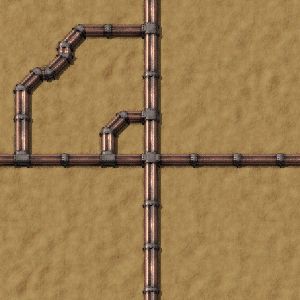Heat pipe: Difference between revisions
m (→History: add to history) |
mNo edit summary |
||
| (3 intermediate revisions by the same user not shown) | |||
| Line 7: | Line 7: | ||
As heat pipes rise in temperature, they will give off a very low-distance glow. | As heat pipes rise in temperature, they will give off a very low-distance glow. | ||
== Heat pipe throughput == | |||
Heat pipes are acting very similarly to fluid [[pipe]]s: they each hold an amount of heat energy and there is a limit to how much energy can go through each of them for a given duration. | |||
For any heat pipe entity with one input connection on one side and one output connection on another, this entity with lower the temperature by <code>1 + (P / 15) °C</code> with P being the power going through this entity expressed in MW. | |||
Since a nuclear power plant can have at most 500°C difference between the hottest (a [[nuclear reactor]]) and coldest (a [[heat exchanger]]) points of the system, that means that we can express the maximum length of a straight line of heat pipe as <code>500 / (1 + P/15)</code>. | |||
For example let's take a single [[nuclear reactor]] outputting 40MW of heat power to a single line of heat pipes. The furthest that line can go is <code>500 / (1 + 40/15)</code> which is around 136 heat pipes long. | |||
== History == | == History == | ||
Latest revision as of 22:25, 15 September 2022
| Heat pipe |
|
Recipe |
|
| + + → | |
|
Total raw |
|
| + + |
|
Map color |
|
|
Health |
200 |
|
Resistances |
Explosion: 0/30% |
|
Stack size |
50 |
|
Dimensions |
1×1 |
|
Maximum temperature |
1000 °C |
|
Mining time |
0.1 |
|
Prototype type |
|
|
Internal name |
heat-pipe |
|
Required technologies |
|
|
Produced by |
|
The heat pipe can transport heat over longer distances and connect devices which produce and use heat. Currently this is limited to heat exchangers and nuclear reactors.
Heat pipes have a heat capacity of 1 MJ/°C. Thus, they can theoretically buffer 500 MJ of heat energy across their working range of 500°C to 1000°C, making them a space-efficient energy store. However, because temperature needs a drop of greater than 1 degree before it will "flow," you can't raise them all the way to 1000°C or drain them all the way to 500°C, so the practical energy capacity will depend on the layout.
As heat pipes rise in temperature, they will give off a very low-distance glow.
Heat pipe throughput
Heat pipes are acting very similarly to fluid pipes: they each hold an amount of heat energy and there is a limit to how much energy can go through each of them for a given duration.
For any heat pipe entity with one input connection on one side and one output connection on another, this entity with lower the temperature by 1 + (P / 15) °C with P being the power going through this entity expressed in MW.
Since a nuclear power plant can have at most 500°C difference between the hottest (a nuclear reactor) and coldest (a heat exchanger) points of the system, that means that we can express the maximum length of a straight line of heat pipe as 500 / (1 + P/15).
For example let's take a single nuclear reactor outputting 40MW of heat power to a single line of heat pipes. The furthest that line can go is 500 / (1 + 40/15) which is around 136 heat pipes long.
History
- 0.17.67:
- Heat pipes (also in reactors and heat exchangers) glow with high temperatures.
- 0.15.11:
- Changed heat transfer mechanics, prior to this heat would flow better following the order of heat pipe placement
- 0.15.0:
- Introduced
See also
